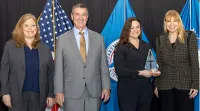 Eastern Washington crash scene (Photo by Amanda Houck)
Eastern Washington crash scene (Photo by Amanda Houck)
While returning from the Washington State Fusion Center’s Crime and Safety Conference with a co-worker, TSA Field Intelligence Officer (FIO) Amanda Houck drove up on a scene that looked like it had fallen from the pages of a Stephen King novel.
The early afternoon storm was hazardous – a snowy, foggy, sleet-driven, winter day. Vehicles were spread across an area the size of a football field, with rolled cars thrown to the side of the road.
“Just before coming up on the scene, I had no visibility and slowed down,” remembered Houck, who is based in Spokane, Washington and works for Intelligence and Analysis. “I saw the headlights of the vehicle that had spun off ahead of me, and then I saw the female victim on the ground, near a car.”
“I felt a bit scared,” said Houck. “There was oncoming traffic and I couldn’t see. People were driving through the area, headlights eerily reflecting in the fog and sleet. I was afraid I might find someone deceased.”
Seeing the chaos of overturned cars, mangled metal on the road, and victims before her, Houck alerted police, fire and emergency services (most were rural volunteers) and described the scene.
Then moving quickly among the vehicles, Houck evaluated the situation as her Coast Guard seaman training (first responder medical) started to kick in. A quick triage of the site and victims revealed an unconscious woman in a snowbank and a man with a bleeding head wound trapped in a crashed truck.
Intending to assist the unconscious woman first, Houck attempted to cover her with an emergency blanket. “I tried to cover her without moving her,” said Houck. “I didn’t know what kind of injuries she had and didn’t want to move her because she was partially embedded in a heavy snowbank. I couldn’t talk with her as she was mumbling and going in and out of consciousness.”
Once the woman was covered, Houck moved to the truck driver, who was bleeding heavily from a head wound and trapped in his vehicle. While not able to physically reach him, she was able to provide bandages for the contusions to his head and directed him to use them as a compress which slowed the bleeding.
“The poor man didn’t speak English and kept saying a woman’s name over and over,” recalled Houck. “I tried to assure him that he was OK and the woman was nearby.”
Houck’s calm demeanor and well-honed first responder medical knowledge proved vitally important as she moved from vehicle to vehicle, working the patient flow and providing first aid along with steadying words of encouragement.
“Flares were lit,” recalled Houck, “But I was afraid I was going to be hit by passersby.”
The local EMS team finally arrived 40 minutes later after sustaining damage to the unit’s rear bumper in an accident of their own. Houck learned there were several other accidents on either side of her scene, one involving a school bus and several cars. As a result, only one damaged ambulance staffed with a driver and a single EMT were available for crash victims under Houck’s care.
Houck and the emergency crew pried the vehicle door open and carried the truck driver on a stretcher to the ambulance. The damaged bumper made access to the working side of the ambulance difficult to access and treat patients. Though the details of the police incident report and what happened to the victims were never known to Houck, her actions that day were clearly above and beyond.
The actions of Amanda Houck on this terrible day, including her selfless attitude in placing the welfare and needs of others above her own, is a tribute to her unflappable demeanor, decisiveness and overall professionalism, all while confronting a multitude of challenges in a sea of turmoil and distress.
“An employee who always rises to the greatest challenge, Amanda reacted instinctively to administer life saving measures, without regard for her own personal welfare,” commented Intelligence Analysis AA Nancy Nykamp. “I am immensely proud of her life-saving heroism.”
By Wayne Carey, Strategic Communications & Public Affairs


